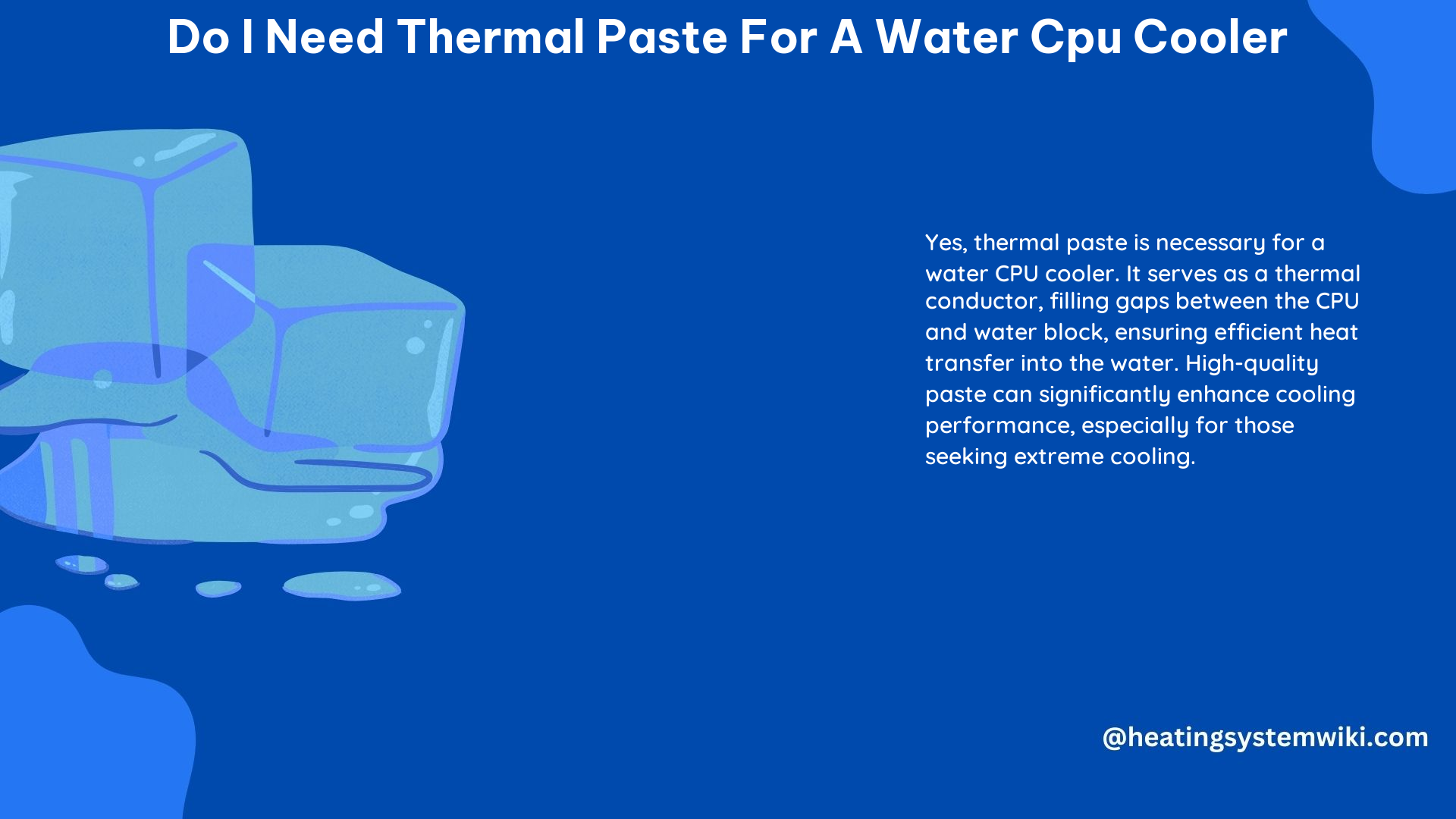When it comes to building a high-performance water-cooled PC, the use of thermal paste is a critical component that should not be overlooked. Thermal paste, also known as thermal interface material (TIM), plays a vital role in ensuring efficient heat transfer between the CPU and the water block in a liquid cooling system.
The Importance of Thermal Paste in Water Cooling
Thermal paste is essential in a water cooling setup for several reasons:
-
Heat Transfer Efficiency: The CPU generates a significant amount of heat during operation, and this heat needs to be efficiently transferred to the water block for effective cooling. Thermal paste acts as a gap filler, occupying the microscopic spaces between the CPU and the water block’s surface. This ensures optimal thermal conductivity, allowing the heat to be quickly and effectively transferred from the CPU to the water block.
-
Improved Cooling Performance: The quality of the thermal paste used can have a significant impact on the overall cooling performance of the water cooling system. High-quality thermal pastes, such as those made with metal-based or ceramic-based compounds, offer superior thermal conductivity compared to lower-quality options. This translates to better heat dissipation and lower CPU temperatures, ultimately improving system stability and longevity.
-
Reduced Thermal Resistance: Thermal paste helps to reduce the thermal resistance between the CPU and the water block, which is crucial for efficient heat transfer. Without thermal paste, the air gaps between the two surfaces would act as an insulator, hindering the heat transfer process and leading to higher CPU temperatures.
-
Consistent Contact: Thermal paste ensures a consistent and even contact between the CPU and the water block, even if the surfaces are not perfectly flat. This helps to distribute the heat evenly across the entire contact area, further improving the cooling efficiency.
Choosing the Right Thermal Paste

When selecting a thermal paste for your water cooling setup, there are several factors to consider:
-
Thermal Conductivity: The thermal conductivity of the paste is a crucial factor, as it determines how effectively the heat can be transferred from the CPU to the water block. Higher thermal conductivity values, typically measured in W/m-K (watts per meter-Kelvin), indicate better heat transfer capabilities.
-
Viscosity: The viscosity of the thermal paste affects its ease of application and ability to fill in the microscopic gaps between the CPU and the water block. A paste with the right viscosity will spread evenly and provide a uniform layer, ensuring optimal contact.
-
Curing Time: Some thermal pastes require a curing or break-in period before they reach their full thermal performance. It’s important to consider the curing time and follow the manufacturer’s recommendations to ensure the best results.
-
Longevity: The longevity of the thermal paste is also an important factor, as you want a product that will maintain its thermal properties over time and not dry out or degrade prematurely.
-
Ease of Application: The ease of application can also be a consideration, as some thermal pastes may be more challenging to spread evenly than others.
Here’s a table comparing some popular thermal paste options for water cooling:
| Thermal Paste | Thermal Conductivity (W/m-K) | Viscosity | Curing Time | Longevity |
|---|---|---|---|---|
| Arctic MX-4 | 8.5 | Medium | None | 8+ years |
| Thermal Grizzly Kryonaut | 12.5 | Medium | None | 3-5 years |
| Noctua NT-H1 | 5.6 | Medium | None | 5+ years |
| Corsair TM30 | 7.0 | Medium | None | 5+ years |
| Gelid GC-Extreme | 8.5 | Medium | None | 5+ years |
Applying Thermal Paste Properly
Proper application of thermal paste is crucial for ensuring optimal heat transfer in a water cooling system. Here’s a step-by-step guide:
-
Prepare the Surface: Before applying the thermal paste, ensure that the CPU and the water block surfaces are clean and free of any debris or residue. You can use a lint-free cloth or a small amount of isopropyl alcohol to clean the surfaces.
-
Apply the Thermal Paste: Apply a small amount of thermal paste, typically the size of a pea or a rice grain, in the center of the CPU. Avoid using too much, as this can lead to excess paste being squeezed out and creating a mess.
-
Spread the Paste: When placing the water block back onto the CPU, gently press down and spread the thermal paste evenly across the entire surface. This can be done by gently rocking the water block back and forth or using a clean, flat object to spread the paste.
-
Avoid Air Bubbles: Make sure to apply even pressure when placing the water block to prevent the formation of air bubbles, which can negatively impact the thermal conductivity.
-
Secure the Water Block: Once the thermal paste is evenly distributed, secure the water block to the CPU according to the manufacturer’s instructions, ensuring a tight and secure fit.
-
Monitor Temperatures: After the installation, monitor the CPU temperatures during operation to ensure that the water cooling system is functioning as expected. If the temperatures are higher than expected, you may need to reapply the thermal paste or check for any other issues in the cooling system.
Conclusion
In a water cooling setup, the use of high-quality thermal paste is essential for ensuring efficient heat transfer from the CPU to the water block. By carefully selecting the right thermal paste and applying it properly, you can maximize the cooling performance of your water cooling system and maintain the long-term stability and reliability of your high-performance PC.
Reference:
– Arctic MX-4 Thermal Paste
– Thermal Grizzly Kryonaut Thermal Paste
– Noctua NT-H1 Thermal Paste
– Corsair TM30 Thermal Paste
– Gelid GC-Extreme Thermal Paste
